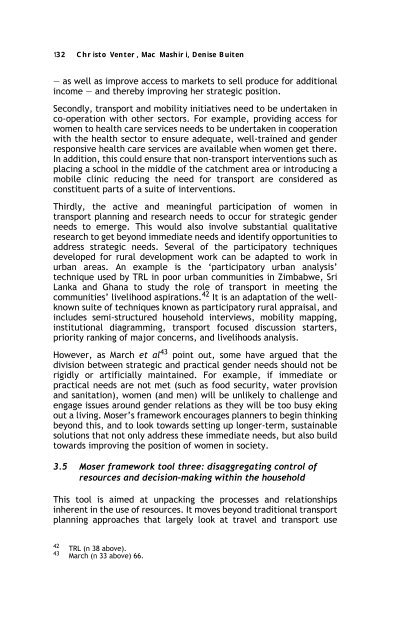Sex, Gender, Becoming - PULP
Sex, Gender, Becoming - PULP
Sex, Gender, Becoming - PULP
You also want an ePaper? Increase the reach of your titles
YUMPU automatically turns print PDFs into web optimized ePapers that Google loves.
132 Christo Venter, Mac Mashiri, Denise Buiten<br />
— as well as improve access to markets to sell produce for additional<br />
income — and thereby improving her strategic position.<br />
Secondly, transport and mobility initiatives need to be undertaken in<br />
co-operation with other sectors. For example, providing access for<br />
women to health care services needs to be undertaken in cooperation<br />
with the health sector to ensure adequate, well-trained and gender<br />
responsive health care services are available when women get there.<br />
In addition, this could ensure that non-transport interventions such as<br />
placing a school in the middle of the catchment area or introducing a<br />
mobile clinic reducing the need for transport are considered as<br />
constituent parts of a suite of interventions.<br />
Thirdly, the active and meaningful participation of women in<br />
transport planning and research needs to occur for strategic gender<br />
needs to emerge. This would also involve substantial qualitative<br />
research to get beyond immediate needs and identify opportunities to<br />
address strategic needs. Several of the participatory techniques<br />
developed for rural development work can be adapted to work in<br />
urban areas. An example is the ‘participatory urban analysis’<br />
technique used by TRL in poor urban communities in Zimbabwe, Sri<br />
Lanka and Ghana to study the role of transport in meeting the<br />
communities’ livelihood aspirations. 42 It is an adaptation of the wellknown<br />
suite of techniques known as participatory rural appraisal, and<br />
includes semi-structured household interviews, mobility mapping,<br />
institutional diagramming, transport focused discussion starters,<br />
priority ranking of major concerns, and livelihoods analysis.<br />
However, as March et al 43 point out, some have argued that the<br />
division between strategic and practical gender needs should not be<br />
rigidly or artificially maintained. For example, if immediate or<br />
practical needs are not met (such as food security, water provision<br />
and sanitation), women (and men) will be unlikely to challenge and<br />
engage issues around gender relations as they will be too busy eking<br />
out a living. Moser’s framework encourages planners to begin thinking<br />
beyond this, and to look towards setting up longer-term, sustainable<br />
solutions that not only address these immediate needs, but also build<br />
towards improving the position of women in society.<br />
3.5 Moser framework tool three: disaggregating control of<br />
resources and decision-making within the household<br />
This tool is aimed at unpacking the processes and relationships<br />
inherent in the use of resources. It moves beyond traditional transport<br />
planning approaches that largely look at travel and transport use<br />
42<br />
TRL (n 38 above).<br />
43 March (n 33 above) 66.
















